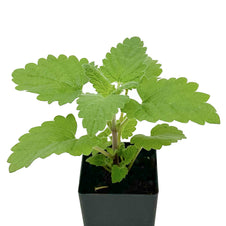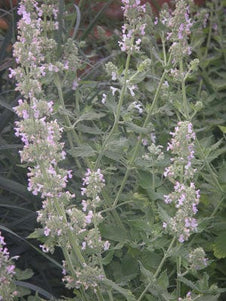





Catnip
Catnip

- In stock, ready to ship
- Inventory on the way

Usually available: All year
Life cycle: Perennial
Height: 90cm - 1.4m
Position: Sun / part shade
Soil preference: Well drained
This is how we pack and send your Herb Plants to all states except TAS & WA
You will receive
- 1 Catnip Herb Plant in a 50 X 75mm tube - General growing instructions
All of our Herb Plants are grown organically with certified organic potting mixes and fertilizers
Botanical Name: Nepeta cataria
Catnip is an herbaceous perennial from the mint family, growing from 90cm to 1.4 meters tall. The square shaped stems are straight with green, triangular to ovate leaves. The gently fragrant leaves have scalloped edges and could be described as ‘coarse’, with grey-white hairs on the underside. In spring or summer, the long blooming flowers grow on spikes and are white with purple spots. The flowers are small, but put on a delicate, lightly fragrant show.
There is approximately 250 species of plant in the Lamiaceace family, collectively known as the ‘catnips’. The genus, Nepeta, takes its reference from an ancient Etruscan city called Nepete. Most are perennials, with a range from 30cm to over a meter high in their ideal environment. The family of catnip herbs are native to Europe, Africa and South West Central Asia, and have been naturalised to North America. Some are cultivated as ornamentals and are good bird, bee and butterfly attractants.
Most people tend to associate catnip with the potential for influencing the behaviour of cats. However, if the plants are intact in your garden the cats will probably not be interested. Two thirds of cats are said to be affected, with the result being cats that roll around, paw at the plant, meow and even eat the plant. They may later settle into a relaxed, sleepy state. Cat response, including big cats such as lions, is based on inheritance of a specific gene that results in sensitivity to the chemical nepetalactone. Cats that are younger than six months and those carrying a genome from an area where catnip is not native are unaffected.
Growing Conditions
Catnip is a plant that thrives in partial shade. However, it needs at least 6 hours of direct sun per day and can also do well in full sun. You may need to ‘test’ out your garden position to make sure the sun is not too direct or hot. This herb will thrive and grow the bushiest when planted in moist, well drained, moderately enriched soils. However, it is somewhat drought tolerant and will grow well in dry sandy soil, as long as water is supplied in hot periods. The combination of humid, wet conditions does not work well for catnip, so tropical regions may not be suitable. If you pinch out the flower buds then it will grow bushier. Pruning may also help if the plant gets too big or straggly for your personal liking.
Catnip has tiny seeds and self-sows very easily. It will reappear each year, if you are happy to let the seeds disperse naturally. You may also start seeds in seed trays, ready for planting out each year as soon as the weather begins to warm in early spring. Mature clumps can be successfully divided. Cuttings may also be used for propagation, with young fresh shoots sending out roots very quickly in about 10 days. Catnip may be grown in pots where frost or lack of space is an issue.
The fresh leaves can be harvested at any time, although the young leaves picked before flowering are milder to taste. To dry, collect complete stems, including the flowers by cutting close to the ground. Hang them upside down in the shade. Once they are dry, strip off the leaves and place them in an airtight jar and keep in a dark place.
Medicinal Uses
The use of catnip for medicinal purposes has been selectively reduced over time, surpassed by stronger or more effective modern medicine. However, catnip has had many traditional uses for treating a variety of health issues and may be useful for its mild and relaxant effects. The active constituents include nepetalactone which has a structure similar to the valepostriates, which are responsible for the sedative properties of valerian root.
Traditionally catnip was used for respiratory conditions and used at the first sign of cold and flu. The relaxant effect is useful for easing tension headaches, digestive problems and menstrual cramps. There is suggestion it was used as a tincture to rub on arthritic joints. Catnip may also have a slight diuretic effect and is best avoided if pregnant. Generally, the herb has a mild effect and has potential for calming, sleep inducing and anxiety reducing effects.
Catnip also has an antiseptic use for skin problems and the tannins speed skin healing for small wounds, cuts, insect bites and inflammation. An eye wash for relieving inflammation may be prepared and used several times a day. The Native Americans from the Ozark and Appalachian Mountain regions used to mash fresh leaves and apply it directly to the mouth and gums, or sore teeth, to bring effective pain relief. Fresh leaves apparently worked almost immediately, while dried leaves took longer. Modern usage would entail using cotton wool to hold the leaves pressed against the offending part of the mouth.
The active ingredients are released by steam distillation. To make an eye wash, use 5 cups of hot water to 5 teaspoons of leaves, steep 50 minutes and then cool and refrigerate in a sealed glass jar. For a tea infusion use 250mls of hot water, add 1-3 teaspoons of leaves and steep for 20 minutes until lukewarm. Catnip is often mixed with honey and elderflower.
Culinary Uses
As early as the 13th century, catnip was commonly found in kitchen gardens. It was used for rubbing on meat before cooking and chopped and sprinkled into salads. The fresh or dried herbs were added to stews, soups, sauces and used in teas, either therapeutically or simply for a relaxing herbal tea. In addition to making your own catnip tea, you can add the leaves to normal black tea, with mint or lemon balm for additional interest. Different quantities of leaves, dried or fresh, the amount of water and the time steeped all alter the taste of catnip herbal tea. Up to 3 teaspoons of leaves in 250 mls of hot water is recommended, but there is great variation. Honey may be added to suit your taste.
Other Uses
Cats
Fresh whole leaves can be placed into small bags and sewn up for cats to play with. Alternatively the plants can be placed in the garden, but cats will only be affected by the plant if they brush up against the leaves, breaking or bruising them to release the chemicals. Other plants that cat are attracted too are cat thyme or cat grass.
Rats
Traditional uses for catnip included placing shredded catnip in areas frequented by rats (and mice) which was said to deter them. Hanging bunches of catnip in chicken and poultry yards was also said to work to deter pests.
Insects
One of the volatile oils in catnip is citronellol, which is useful as an insect repellent when distilled. It is said to be useful against mosquitos and aphids.
All information provided on this website is for informational purposes only. Please seek professional advice before commencing any treatment.





